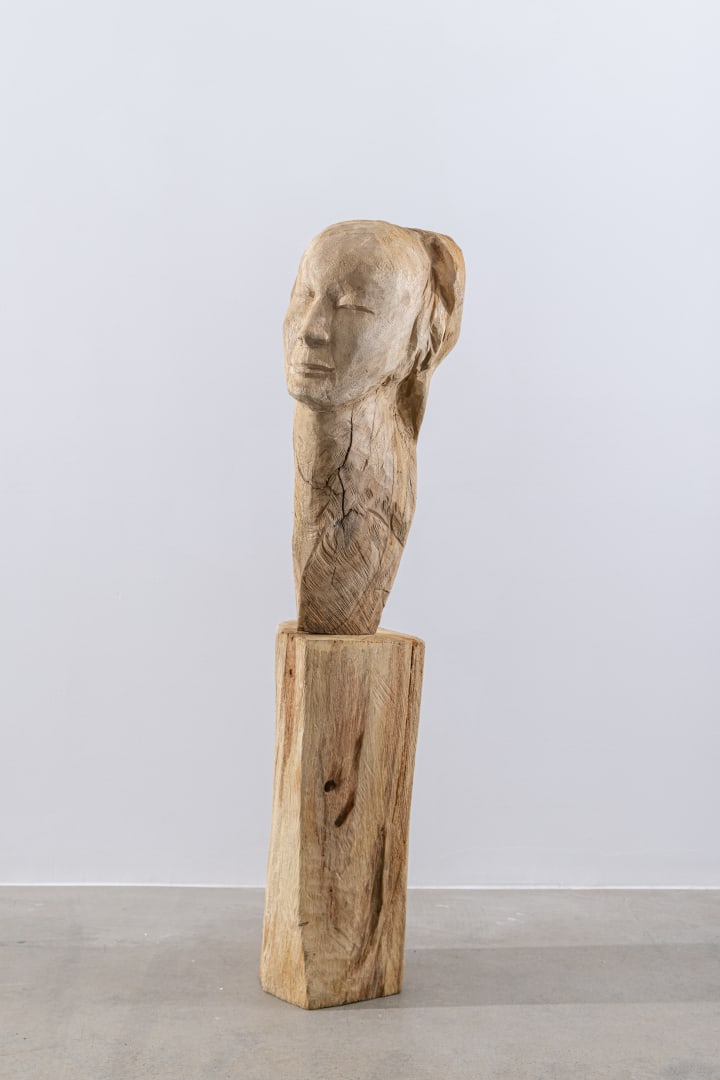JEMS KOKO BI
Postcolonial Melancholy under the Sign of the Hummingbird
Born from the Forest, the engraver, sculptor, and performer Koko Bi partially owes his sensitive genius to his early babbling in wood, echoing the song of bird witnesses. A native of the Gouro region in the Central West, in the vegetal heart of Ivory Coast, he is familiar from early childhood with societal, spiritual, and formal concepts from a long tradition of "woodcutters" for both secular and sacred purposes.
Primarily concerned with the elegance of movement, the finesse of curves, and the beauty of representation, the Gouro Masters have bequeathed to heritage masks and dances of renown such as Zaouli or Djé, which still embellish our festive ceremonies and continue to shape our popular imagination.
From this cultural ethos, blending veneration for wood with the valorization of strength, Koko Bi draws an aesthetic in the minimalist space between abstraction and figuration. The raw rendering of his chainsaw cut, the work on the bark, and the acuity of lines give wood a form of nudity, a character that is remarkably alive, an almost carnal voluptuousness.
Entering the luminous intimacy of his work reveals it as one of the most phosphorescent successors at the Academy of Fine Arts in Düsseldorf (Joseph Beuys), carrying interrogations that are anthropological, ecological, ethical, and moral all at once. His narratives are fundamentally political in the sharpest sense of the word, turned towards the awakening of the city. Sculpting, from his perspective, is a therapeutic process, a way of healing the wounds of the universe. Unlike Beuys, Koko Bi does not seek to reconcile nature and culture but rather to reconcile a multidimensional nature with itself.
Memory Returns.
Inspired by one of my intuitions during a discussion in the industrial landscape of the Ruhr Museum in Essen, approaching the Fiftieth Anniversary of our country's independence, and matured for 13 years by the artist, the installation "Soul Train" (2023) comprises three blocks sculpted in the southern region of Mé. This creation is structured around colonial machinery (the rail, the rifle, the symbol of the whip), its actors (the Colonizer, his Indigenous accomplice, and the Colonized), as well as the unspoken aspect of an industry of dehumanization, savagery, and barbarism.
Confronted with the disaster of the imposing scene of monumental trees lying in swampy waters, the sculptor inquires with the locals about the identity of those responsible for the sacrilege, the prevailing environmental catastrophe. His hosts inform him that the site was a colonial concession, abandoned by a French timber operator around 1929, marked by "the great depression." A speculative and financial crisis that shook the post-industrial economic and fiduciary system. A monetary crisis in the dollarized world, with the Wall Street stock market crash being the most spectacular manifestation.
These Vestiges of Mé provoke in Koko Bi a return of history of domination and its logic of extraction, a call from the wood under climatic constraints that impose a challenge. The two species of wood present, Dabéma (Pepper wood) and Badi, were used in the manual construction of bridges and railway ties, the infrastructure that served the "development of the territory," i.e., the exploitation of its resources.
Past (re)composed.
The central figure of "Soul Train" is indeed that of the "Colonized," subjected to the alchemical test of purifying fire. Its muscular robustness, the fullness of its volumetry, contrast with the inner void of a zombified counterpart, seemingly sustained only by the accouterments of authority (helmet, lethal weapon, boots). In this relationship between fullness and emptiness, horizontality and verticality, there is a mise en abîme of Brancusi's stylistic considerations on the gaze's promenade. grappling with the mass, Koko Bi has disarticulated the morphology of the subject, as if echoing an ecological parable. The dismembered man, suffering servant, and the forest ecosystem are the emissary victims of the same blind violence. His narrative imposes itself with the narrative fluidity of bas-relief effects. There is also a similarity in the tragedy of the mutilated body and the felled trunks. The sculptor transforms his inanimate material into regenerated life force. The "Colonized," an icon of forced labor and compulsory culture, merges with the rail, the instrument par excellence of his torture. It serves as an ancestor to the sculptor and reflects the peasant origins of the national emancipation narrative.
History in the Present.
Koko Bi's "Colonizer" diverges radically from the eponymous statuary, a trend promoted under the empire, over time becoming the master standard of tourist craftsmanship.This headless character embodies the allegory of conquest, power devices: command auxiliaries; the cohort of collaborating chiefs, interpreters, Circle guards; harassment in all its forms and latitudes. In the sculptor's plastic lexicon, it is equivalent to the totem of the chair, just as the train substitutes for the boat, migratory exodus for the agricultural trade economy.
Afterwards, Koko Bi resurrects "The Predators" (2022), a testimony presented in the Ivory Coast Pavilion at the 14th Dak'art Contemporary Art Biennial, where six characters in a round emphasize, by contrast, the geographical and historical continuum of the negative work of tyranny. This suggests that practices inherited from colonization play out invariably before our eyes.
Like a demiurge, the artist emerges from the waters "Hommage à toi," an enigmatic floral hand, a note of tenderness. This celebration of the planter's tool, a propitiatory gesture, an almost rose, reminds us, beyond wounded souls, of the poetry of the forest.
Thus, from the endless embrace of the fusion of lovers to twinship, carried to the peaks by the magic of love ("Ton pied mon pied," 2023), or a boat with the slender line of the surveyor ("Ndjolefen," 2023). Ndjolefen ? A word in Wolof meaning: together to resist. It is the name given to a multicultural urban village in Saint-Louis, Senegal, an invitation to the Unity of the Continent to stand solidly against colonial destruction...
Franck Hermann Ekra
Art critic, independent curator

